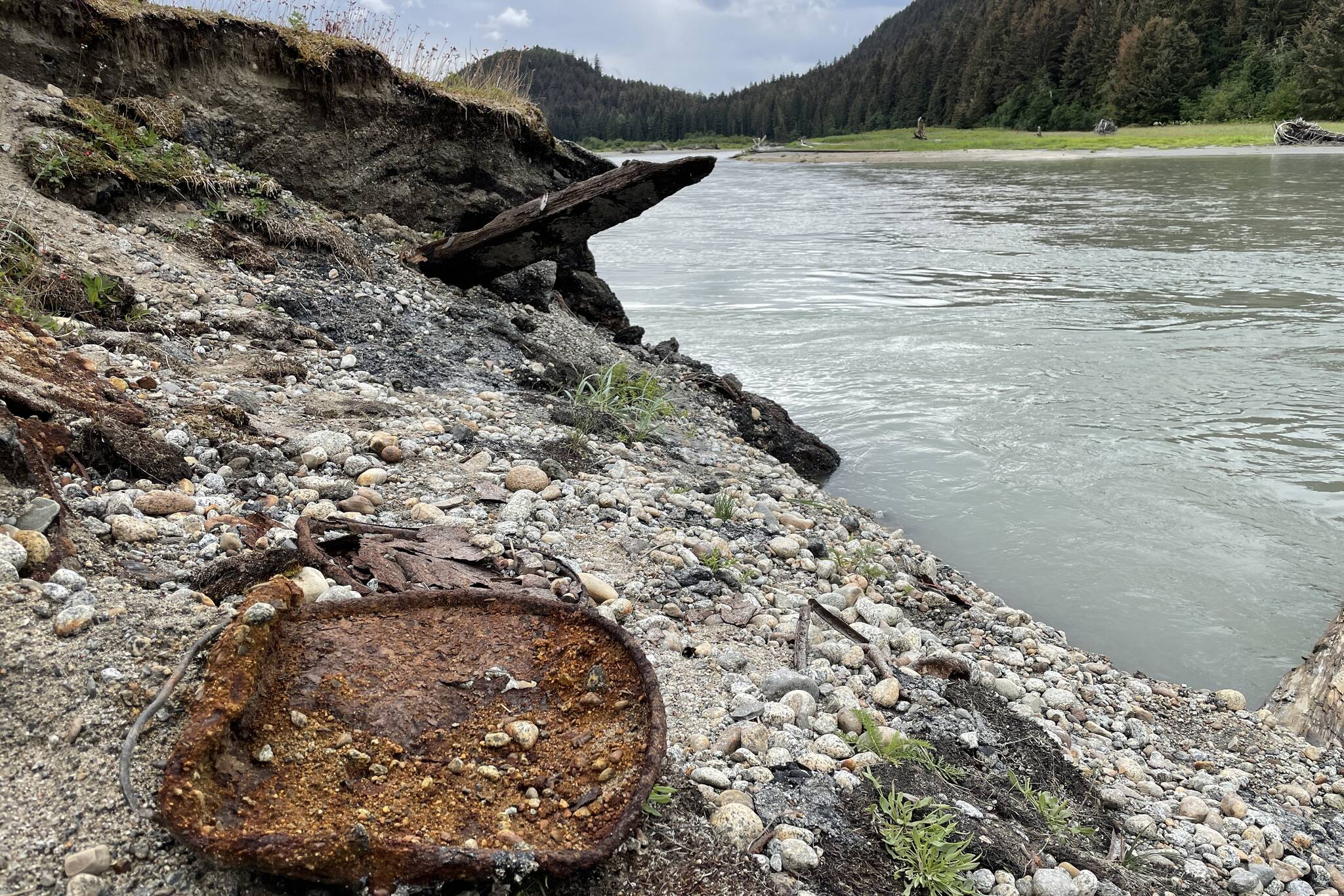Riverbank erosion near Eagle Beach State Park has revealed several decades-old oil drums and other industrial debris that were formerly buried.
The issue isn’t a new one, said the chief ranger for the state parks in the Southeast Region, but the eroding riverbank does complicate the issue.
“So it’s actually an ongoing issue. It’s been a couple years now that the riverbank has been eroding. As it’s been eroding it’s been exposing the debris that was under the hill, said Chief Ranger Brad Garasky. “When it was first discovered it was reported to (the Department of Environmental Conservation). We’re working with DEC on a cleanup and containment plan.”
[Coast Guard announces penalties against fishing vessels]
The rusted debris and tarry oil residue comes from decades-old roadbuilding infrastructure, Garasky said.
“The debris is actually from an old DOT asphalt batch plant when they did the roadwork out there,” Garasky said. “I guess standard operating procedure back in the day was to bury the stuff they were done with on site. There’s big chunks of asphalt that they pushed out on the riverbank as well.”
A contractor, not the Department of Transportation and Public Facilities, is responsible for burying the oil barrels there, said Sam Dapcevich, a DOTPF spokesperson.
It isn’t the first call the National Response Center for oil spills has gotten about it, said Petty Officer 2nd Class Bradley Nystrom, a pollution responder with Coast Guard District 17. But now the scale of the issue is more visible.
“We’ve gotten a call about this before — last year, someone called this but there wasn’t a lot we could see,” Nystrom said in a phone interview. “Now that the banks have eroded a lot more we can see a lot more.”
Threats and responses
While there is some evidence that some content is seeping out, it’s not an immediate environmental threat, according to the Coast Guard, who, along with state agencies, is coordinating the cleanup.
“They’re really rusted. They’re really degraded metal barrels, 55-gallon drums. It looks like a lot of the oil in them has solidified. What’s left in them is pretty much tar,” Nystrom said. “What’s left is seeping out a little bit, but it’s not an imminent threat to the environment.”
If that threat changes, Nystrom, so will the Coast Guard’s position. But for now, the service will work with the other organizations to come up with a measured response.
“If it becomes an oil spill it becomes my jurisdiction,” Nystrom said. “This is kind of new to us. We’re going to work with them and figure out the best response.”
The debris was tested by state agencies and found nonhazardous, Garasky said.
“There’s multiple agencies working on solutions and funding sources,” Garasky said. “We’ve had the materials tested and it came back non hazardous to humans and wildlife.”
Most or all of the lighter petrochemical products that would cause things like liquid spills or sheening on the surface of the water appear to be gone, Nystrom said.
“What I noticed is a lot of heavy tar,” Nystrom said. “Light ends are the thin parts of the oil that tend to evaporate. They take the light ends out of crude oil and use it to make gasoline.”
The extent of the buried debris is uncertain, Garasky said, but the more riverbank gets eroded, the more debris appears.
Wearing away the riverbanks
The position of the debris, on the precipitously eroding riverbank, makes its removal precarious, Nystrom said.
“The state park’s position is mostly that they want to get rid of the soil, the tar, but that means excavating part of the riverbank,” Nystrom said. “You have to weigh the consequences.”
At the present, state parks personnel are removing the debris and storing it for disposal as practical, Garasky said.
“We will remove from the bank what we can before it finds its way to the banks and disappears forever,” Garasky said. “We stage it on site with an impermeable barrier until we have enough to make a run.”
For now, both Nystrom and Garasky said park-goers should avoid the riverbank, which people should be standing clear of as a matter of course.
“It’s a crumbling riverbank. There’s a whole safety issue,” Nystrom said. “And there’s rusty metal. We don’t want kids playing near it.”
That same erosion is threatening other park infrastructure, with the park personnel closing a wildlife observation area that the riverbank is wearing away and threatening Saturday Creek Cabin.
“The area that’s roped off was kind of a wildlife viewing area,” Garasky said. “We’ve had to take down a bunch of infrastructure that was there before it got sucked into the river.”
Stopgap measures were put in place to shore up the riverbank near the cabin while the permitting process for a longer-term solution was worked through, Garasky said. Now, permits from all appropriate agencies have been secured and the parks division is simply seeking funding to enact the solution.
“We have the working plans drawn up. It’s a funding issue at this time,” Garasky said. “With every high water event, there’s more riverbank erosion. With more erosion, more debris gets exposed.”
• Contact reporter Michael S. Lockett at 757-621-1197 or mlockett@juneauempire.com.

